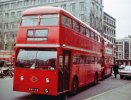The FRM was registered in 1966; Fleetlines entered opo service in 1971 (but were the XA and XF Atlantean and Fleetline buses from 1965 opo?). Originally only single decks were allowed to be opo; I don't know when the law was changed to allow double deck opo, or probably more pertinently, when London Transport (or the Met Police?) allowed it.
The XAs - at least initially - went to the Central Area for crew operation; the XFs to the Country Area, and were fitted for the upper deck to be closed off, enabling operation as a 'single decker' (i.e. lower only) at quieter times: not sure if/to what extent this was actually done.
I think double deck one man operation was legally permitted from about 1967 - adoption by LT then took a while. One of the issues seen at that time was the ability of omo (as it was then known) to cope on high capacity buses (single or double deck), fare collection/ticket issuing wise: a lot of LT's high capacity single decker (MBA, MBS, SMS types) were fitted with ticket machines/turnstiles, rather than passengers being expected to pay the driver.
Getting back to the FRM - my own wondering is as to what extent it was intended as prototype for a production batch of essentially similar vehicles; or as a stage on the route to a new generation Routemaster, using some Routemaster concepts, sub-assemblies and components, but also modified to take advantage of the increased permissable width (2.5m instead of 2.44m), etc - and perhaps including single deck variants.


